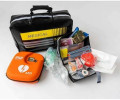New High-Strength, Cost-Effective Seat Standard Set to Improve Safety Across Motor Sport
New FIA Standard improves on seats homologated to 8855, the most widely used in competition.

The FIA has delivered an update to the 8855-1999 seat standard used in closed-cockpit cars, which will significantly improve the safety of the most popular motor sport seat in the world.
With support from R&D technology company D2H Advanced Technologies, the new FIA Standard 8855-2021 requires seats to be much stronger than the original Standard that was issued over 20 years ago. This brings it closer in strength and safety to the FIA Standard 8862-2009 used in top-tier motor sport categories such as the Rally 1 cars in the World Rally Championship.
The new 8855-2021 seats offer an increased level of safety that will be affordable for tens of thousands of teams and competitors worldwide. Strength is judged on the ability of the seat shell to withstand an impact both to the rear and laterally, in this case protecting a competitor in the event of an accident up to 42G.
Adam Baker, FIA Safety Director, said: “The FIA has delivered a new cost-effective 8855-2021 seat Standard that brings it closer to the 8862-2009 seat Standard used in top-tier motor sport categories. With the help of R&D from D2H in developing seat prototypes by optimizing materials and manufacturing techniques, we were able to deliver this very cost-effective Standard. This is great news for motor sport competitors at all levels around the world.”
The FIA Safety Department conducted quasi-static tests where forces are applied to critical areas of the seat shell by controlled loading arms, to simulate the stresses of a high-speed impact. This work was discussed and agreed with the FIA’s Industry Working Group, which is made of motor sport suppliers and equipment manufacturers who help to developing future FIA standards and regulations.
The total forces inflicted on the seats are around two tonnes to core areas that are crucial to crash safety: lumbar, centre of the back and head/neck, and to the sides, including the hips/pelvis region, shoulder and to the side of the head.
As a result of this extensive research the new 8855-2021 seat Standard significantly boosts the strength of the existing specifications, offering 60 per cent of the strength of the top-level 8862 seats but with only marginal weight increase and costing around €500. Homologated 8855-2021 seats will be issued with a 10-year FIA validity compared to the five-year lifespan under the 8855-1999 standard, a major achievement for improved safety affordability.
The FIA Safety, Technical and Sporting Departments and respective FIA Commissions have been discussing the implementation plan of the new seat in categories not using the 8862-2009 seats. Technical regulations mandating 8855-2021 seats will be updated with enough notice once the implementation is approved by from the World Motor Sport Council. Competitors that use 8855-1999 can from 2021 upgrade their seat to 8855-2021 standard.
The 8855-1999 Standard will not be withdrawn, as certain design requirements of the new seats will mean it will not be possible to mandate in every model of competition car.



 Facebook
Facebook Twitter
Twitter






